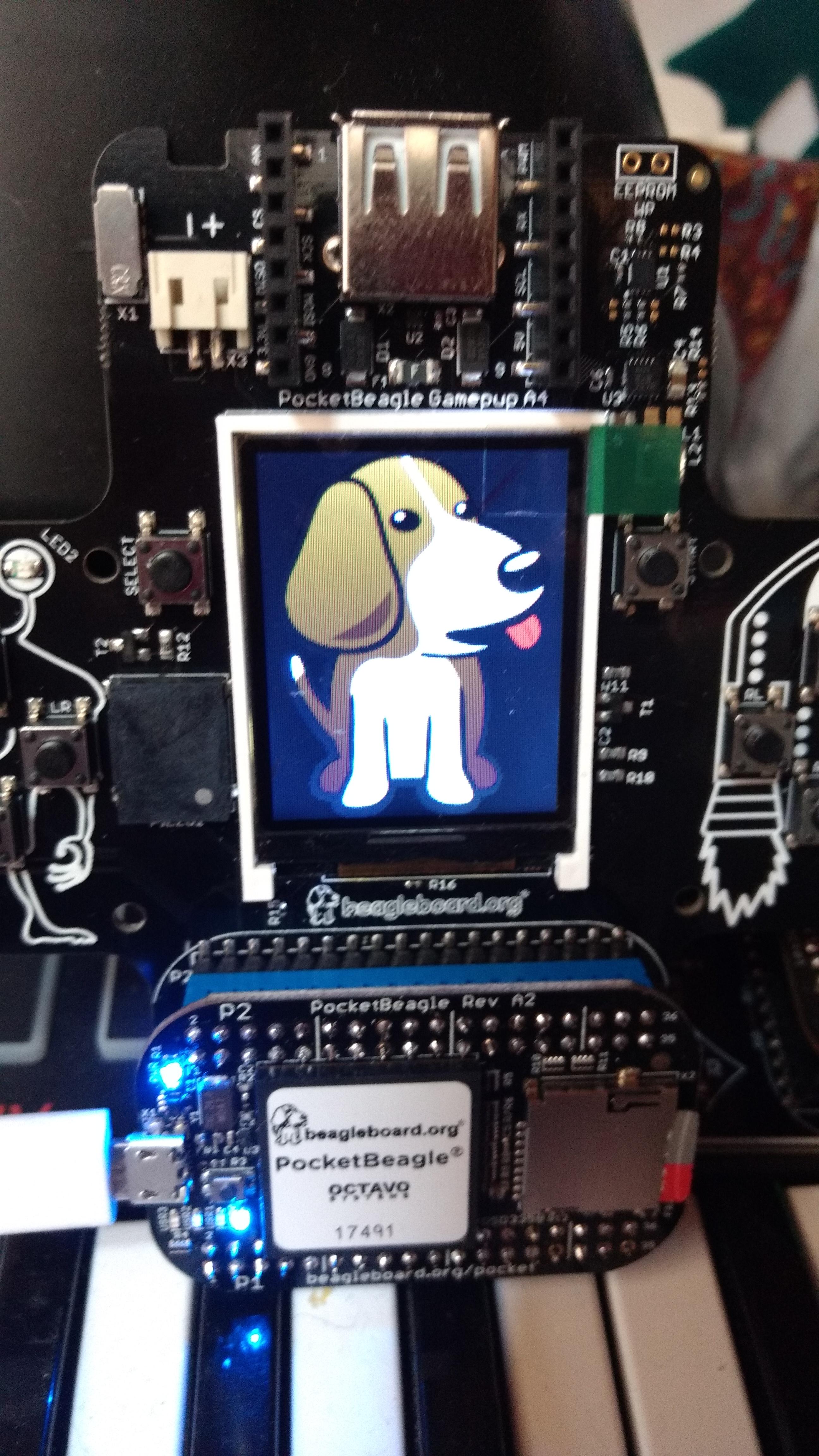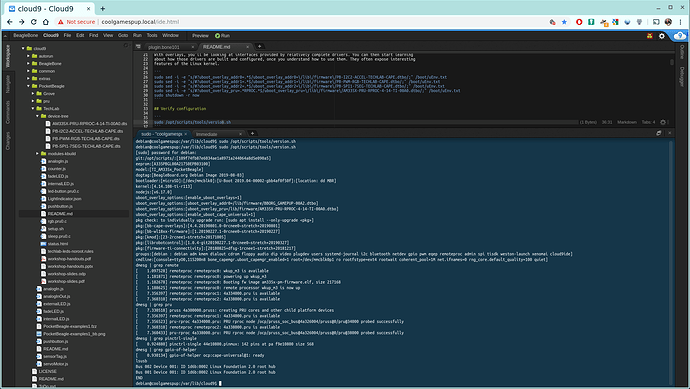Congratulations to Beaglebone for getting into teaching game development !
Attached a browser screen that shows the Game Pup with overlay applied as per instructions at
https://github.com/beagleboard/pocketbeagle/wiki/GamePup-cape shown in Cloud9 IDE !
I only have an issue (previously reported at Adafruit) with Red and Green colors reversed demonstrated by using an install app fbi and fbset.
Confirm the cape is working !
$ fbset -i
mode “128x160”
geometry 128 160 128 160 16
timings 0 0 0 0 0 0 0
nonstd 1
rgba 5/11,6/5,5/0,0/0
endmode
Frame buffer device information:
Name : fb_st7735r
Address : 0
Size : 40960
Type : PACKED PIXELS
Visual : TRUECOLOR
XPanStep : 0
YPanStep : 0
YWrapStep : 0
LineLength : 256
Accelerator : No
Try this command on attached images to see the Pup sized to fit !
sudo fbi -T 1 --noverbose BeagleFromLogo\ for\ PupC.png
or enjoy grayscale for now
sudo fbi -T 1 --noverbose BeagleFromLogo\ for\ PupG.png


I wanted to see the FUTURE so I used GIMP to switch to RGB mode then DECOMPOSE and COMPOSE with reversed to GBR layers.
Looks right on GamePup for now.
Not sure when any work will be done in Linux kernel sources for ST7735r as was done for ADA Fruit on Arduino.


In case you missed it, you need a slightly different command to display this new file.
sudo fbi -T 1 --noverbose BeagleFromLogo\ for\ PupCic.png
I wanted to see the FUTURE so I used GIMP to switch to RGB mode then DECOMPOSE and COMPOSE with reversed to GBR layers.
Looks right on GamePup for now.
Not sure when any work will be done in Linux kernel sources for ST7735r as was done for ADA Fruit on Arduino.
This can be fixed up in the device tree.
I have no knowledge of DEVICE TREE (yet) so I will be delayed but can make it appear to work and pass on to those that may have the knowledge to
fixing up in the device tree.
Again, I am not a programmer only a retired end user that can help test and point out what is not as it should be.
Latest update is contacting Summer of Code 2019 developer to help write the manifest for the MP3 Click
https://vaishnav98.github.io/GSoC19/contact.html
If anyone else has the desire to get Midi music from Gamepup then we are in this together.
Current using Akai MPK mini Play and LPD8 for USB Midi I/O.
https://www.akaipro.com/mpk-mini-play-mpkminiplay
Using timidity or pocket beagle wastes cpu on music tracks.
Atari did this in the 1980’s using MT32
https://en.wikipedia.org/wiki/List_of_MT-32-compatible_computer_games
Almost a month and “device tree” is starting to make sense.
I ordered the Click cape for Beaglebone Black running MACHINEKIT.
Also picked RTC 5 and 9 DOF 1996 Click boards as they seem to be already included in overlay directory
for both Pocket and Black.
Initial test: 9 DOF will be used to control png orientation on Gamepup display.
Techlab with RTC 5 will be variation of gsim blog example that used RTC 6.
I have the Moto Z Play which is mentioned in Greybus at LWN so wanted to do stuff with it’s SDK.
Linux Ubuntu Studio 19.04 → Android Studio → Moto Mod Hat adapter → Pi Click bonnet (1/2 hat for Pi zero) → MP3 Click !
Almost making sense after 35 years away from assembly language (Macro 11) and sysgens for PDP-11 running RSX-11S.
I only built analog radios in 1970 decade.
Both were self taught skills as it was before classes were as easily available in colleges.
Almost a month and “device tree” is starting to make sense.
I ordered the Click cape for Beaglebone Black running MACHINEKIT.
Also picked RTC 5 and 9 DOF 1996 Click boards as they seem to be already included in overlay directory
for both Pocket and Black.
Initial test: 9 DOF will be used to control png orientation on Gamepup display.
Techlab with RTC 5 will be variation of gsim blog example that used RTC 6.
I have the Moto Z Play which is mentioned in Greybus at LWN so wanted to do stuff with it’s SDK.
Linux Ubuntu Studio 19.04 → Android Studio → Moto Mod Hat adapter → Pi Click bonnet (1/2 hat for Pi zero) → MP3 Click !
Almost making sense after 35 years away from assembly language (Macro 11) and sysgens for PDP-11 running RSX-11S.
I only built analog radios in 1970 decade.
Both were self taught skills as it was before classes were as easily available in colleges.
You are taking on the exercise of learning Linux development from many different angles. I’m confused trying to follow your path, but I imagine it is filling in holes for you.
Thanks for keeping us informed.
Jason,
I started in computers without formal training.
First job was building CRT terminals with out a computer to connect.
Later learn hardware testing and the automated circuit testing with DEC PDP-8 paper tape and no disk.
After that used in circuit function tester for DEC PDP-11.
Then taught PDP-11 OS called RSX-11m which is much like X11 and then in 1995 Linux.
My name de plume Event Video is because of preference for TV and video over the computer in the box.
TechLab has Linux but no video so not as attractive as GamePup.
Once GamePup had a working video I began to like it but setting date was tedious so I added the RTC-5 from Mikroe
rather than build something with no skills to design and build hardware.
I started with sysgen on Linux in 1995 on terminal console then X11 so I prefer that operating system over MAC or Windows (by far).
I still plug things in like I know how to do but not designing circuits as is expected for embedded systems.
I also would learn by doing and never breadboard which again goes against the gist of embedded system learning.
As I progress I use various journaling tools like Slack and text files.
Here at Google Groups I can share my progress and maybe make a freind or two at the same level of skills.
The Midi music is still plug and play and my requirements are significantly beyond the small SBC systems for
expressing ideas.
I plan to use virtual reality head mounted stereo display so the Black fits that better with HDMI.
The GamePup will be the game controller when Wifi and bluetooth are plugged into both devices.
My favorite hardware was Sega with Dreamcast being easiest to play with display on the controller as I envision the GamePup for Android TV at Google Stadia (more users than Linux on Black).
https://en.wikipedia.org/wiki/Dreamcast
Who was Sonic ?
Maybe Boris will chase that Hedgehog in an Open Source Blender Movie !
I could imagine 3D printed and VR with Beagleboard AI embedded real time strategies as Midi theme songs play !
That’s Cool Games Network and Event Video Multimedia in an open source hackerspace !
Just need the sources and the community !
Think I see it !
https://github.com/beagleboard/bb.org-overlays/blob/master/src/arm/BBORG_GAMEPUP-00A2.dts#L301
Now how do I apply the changes to my local device ?
src/arm/BBORG_GAMEPUP-00A2.dts:301
bgr;
https://github.com/beagleboard/bb.org-overlays|beagleboard/bb.org-overlaysbeagleboard/bb.org-overlays | Added by GitHub
Cool Games 12:48 PM
I am rebooting after git clone ; install.sh
pico line 301 above on GamePup Beagle
SUCCESS !




